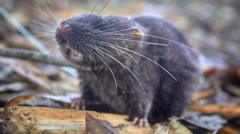Amidst the lush landscapes of the Amazon rainforest in Peru, scientists, alongside local indigenous groups, have unveiled a remarkable collection of 27 new species. One of the most fascinating finds is an amphibious mouse equipped with webbed feet, as well as a unique blob-headed fish, all uncovered during a recent expedition led by the non-profit organization Conservation International.
The expedition took place in a region known as Alto Mayo, an area under protection that is home to diverse ecosystems and indigenous territories. According to Conservation International, up to 48 additional species may also have been identified, pending further research to confirm their status as new discoveries. "Finding so many new mammals and vertebrate species is remarkable, especially in an area heavily impacted by human activity," expressed Trond Larsen, senior director at Conservation International.
Alto Mayo, located in northern Peru, is facing environmental pressures from deforestation and agricultural expansion due to its relatively high population density. Yulisa Tuwi, an Awajún woman who participated in the research, stated, “This report empowers the Awajún to safeguard our culture, natural resources, and territories,” as it enhances their understanding of local ecosystems. Mr. Larsen acknowledged the profound traditional knowledge that the Awajún possess regarding their surrounding flora and fauna.
Among the new species identified were an adorable dwarf squirrel measuring just 14 cm (5.5 inches) long—half the size of the average UK grey squirrel—along with eight different types of fish, three species of amphibians, and ten kinds of butterflies. The newly discovered blob-headed fish stunned scientists with its unusually large head, a feature already familiar to the indigenous Awajún community, who had previously observed the creature.
The newly described spiny mouse gets its name from its distinctive guard hairs that resemble hedgehog spines. The amphibious mouse, on the other hand, is part of a group of semi-aquatic rodents considered some of the rarest in the world, known for their limited sightings in the wild. Other notable findings include a tiny climbing salamander and a marsupial opossum with large ears, emphasizing the expedition's success in illuminating the rich diversity of life thriving in Peru's unique habitats.
The expedition took place in a region known as Alto Mayo, an area under protection that is home to diverse ecosystems and indigenous territories. According to Conservation International, up to 48 additional species may also have been identified, pending further research to confirm their status as new discoveries. "Finding so many new mammals and vertebrate species is remarkable, especially in an area heavily impacted by human activity," expressed Trond Larsen, senior director at Conservation International.
Alto Mayo, located in northern Peru, is facing environmental pressures from deforestation and agricultural expansion due to its relatively high population density. Yulisa Tuwi, an Awajún woman who participated in the research, stated, “This report empowers the Awajún to safeguard our culture, natural resources, and territories,” as it enhances their understanding of local ecosystems. Mr. Larsen acknowledged the profound traditional knowledge that the Awajún possess regarding their surrounding flora and fauna.
Among the new species identified were an adorable dwarf squirrel measuring just 14 cm (5.5 inches) long—half the size of the average UK grey squirrel—along with eight different types of fish, three species of amphibians, and ten kinds of butterflies. The newly discovered blob-headed fish stunned scientists with its unusually large head, a feature already familiar to the indigenous Awajún community, who had previously observed the creature.
The newly described spiny mouse gets its name from its distinctive guard hairs that resemble hedgehog spines. The amphibious mouse, on the other hand, is part of a group of semi-aquatic rodents considered some of the rarest in the world, known for their limited sightings in the wild. Other notable findings include a tiny climbing salamander and a marsupial opossum with large ears, emphasizing the expedition's success in illuminating the rich diversity of life thriving in Peru's unique habitats.


















